Sandiego prospect (Gordon Downs 2), Koongie Park Community, Halls Creek Shire, Western Australia, Australia

| Latitude & Longitude (WGS84): | 18° 22' 4'' South , 127° 27' 21'' East |
|---|---|
| Latitude & Longitude (decimal): | -18.36776,127.45580 |
| GeoHash: | G#: qudxs262p |
| Locality type: | Prospect |
| Köppen climate type: | BSh : Hot semi-arid (steppe) climate |
The main source (Orth) is detailed, and only species mentioned specifically with the deposits in this area are included. The source goes into great detail relating to regional rocks, which has not been included here, but species in these rocks could potentially be found at or near the deposits.
VMS. Massive conformable wedged shaped lens 200 metres long, and maximum thickness of 75 metres, plunging south to south-west. Stratabound with separated sub-parallel copper and zinc lodes, capped by a supergene chalcocite layer. Hosted by the Koongie Park Formation. The sulphide zinc lode contain sphalerite, pyrrhotite, galena, and pyrite. The copper lodes chalcopyrite, pyrite, chalcocite, covellite and marcasite. Tight folding and some faulting provide the local structural controls on mineralisation.
Located 25 kilometres south-west of Halls Creek, and near the Great Northern Highway.
Discovered by Kennecott Exploration (Australia) Limited in the 1970's. Explored by North Broken Hill Pty Ltd and Asarco Australian Limited in the 1980's. Anglo Australian Resources NL gained an interest in the project in 1990, and full ownership from Coffey Mining in 2002. Extensive exploration occurred from 2006 to 2010, and a pre-feasibility study was completed in 2008.
The supergene zone contains an Indicated Resource of 0.37 Mt at 4% Cu, 2.7% Zn, 0.29g/t Au and 48g/t Ag. Inferred 0.01 Mt, 1% Cu, 0.1% Zn, 0.05g/t Au and 3g/t Ag. The copper dominant transition/primary zone has an Indicated Resource of 1.14Mt showing 2.8% Cu, 1.5% Zn, 0.43g/t Au and 12 g/t Ag. Inferred 0.44 Mt with 1.8% Cu, 2% Zn, 0.25g/t Au and 5g/t Ag. The Zinc dominated transition/primary zone has an Indicated Resource of 1.22 Mt showing 0.2% Cu, 7% Zn, 0.16g/t Au, and 26 g/t Ag. Inferred 0.35 Mt showing 0.1% Cu, 6.2% Zn, 0.14 g/t Au and 9 g/t Ag. 0.8% Cu cut-off, and 3% zinc cut-off. Figures produced by Coffey Mining 2010.
The deposit has a chalcocite rich supergene capping, 200 metres long, 80 to 100 metres below the surface, 30 to 40 metres wide, confined by Footwall shales, and Hanging Wall volcanics, with enhanced gold and silver values.
Massive, semi massive, and disseminated sphalerite has been encountered through drilling in the transition (partly weathered zone), with chalcopyrite and pyrite. Also noted at the deposit is abundant high fluorine (1-3%Wt) dark micas (phlogopite/biotite), with accessory ilmenite, zircon, sphene, and minor andradite garnet associated with pyrite, carbonate, and green to brown actinolite and ferroactinolite.
Oxidation and leaching reaches a depth from the surface of 100 to 110 metres. The ore lenses plunge steeply south. They are confined to the cores of isoclinal fold axes, and cut by a series of north-west and east striking shear zones. The surrounding alteration zone is chlorite, actinolite, tremolite, talc, quartz, and carbonate.
The Footwall of the deposit is quartz bearing volcaniclastic units, the Hanging Wall fine grained sandstone interbedded with mudstone, and minor chert and quartz-phyric rhyolite. The rocks are intruded by quartz-phyric and feldspar phyric sills. Calcareous, black and grey mudstone, ironstone, fine grained sandstone, and chert is near or at the contact with the walls.
At Sandiego the shearing is related to movement during a second fold event, with later folding causing buckling, and a slight re-orientation of the sulphide zones, causing abundant microstructures, used by the sulphide mineralisation when mobilised. Folding controls the shape of the lenses which are elongate.
Surface outcropping shows laminated quartz, carbonate and/or iron rich silicate mineralisation often complexly folded accompanying magnetite. This includes up to 1.6mm needle like laths of stilpnomelane, slabby grunerite crystals, and iron rich chlorite. Apatite is associated with the quartz, the quartz usually blue in colour. The quartz bands are cross cut by pyrite and pyrrhotite.
Mineral List
25 valid minerals.
Rock Types Recorded
Select Rock List Type
Alphabetical List Tree DiagramRegional Geology
This geological map and associated information on rock units at or nearby to the coordinates given for this locality is based on relatively small scale geological maps provided by various national Geological Surveys. This does not necessarily represent the complete geology at this locality but it gives a background for the region in which it is found.
Click on geological units on the map for more information. Click here to view full-screen map on Macrostrat.org
| Quaternary - Cenozoic 0 - 66 Ma ID: 712900 | black soil plain 68902 Age: Cenozoic (0 - 66 Ma) Description: Residual black, dark grey or brown clayey soil Comments: regolith; synthesis of multiple published descriptions Lithology: Regolith Reference: Raymond, O.L., Liu, S., Gallagher, R., Zhang, W., Highet, L.M. Surface Geology of Australia 1:1 million scale dataset 2012 edition. Commonwealth of Australia (Geoscience Australia). [5] |
| Stenian - Statherian 1000 - 1800 Ma ID: 3184823 | Paleoproterozoic-Mesoproterozoic intrusive rocks Age: Proterozoic (1000 - 1800 Ma) Comments: King Leopold Orogen Lithology: Intrusive igneous rocks Reference: Chorlton, L.B. Generalized geology of the world: bedrock domains and major faults in GIS format: a small-scale world geology map with an extended geological attribute database. doi: 10.4095/223767. Geological Survey of Canada, Open File 5529. [154] |
Data and map coding provided by Macrostrat.org, used under Creative Commons Attribution 4.0 License



